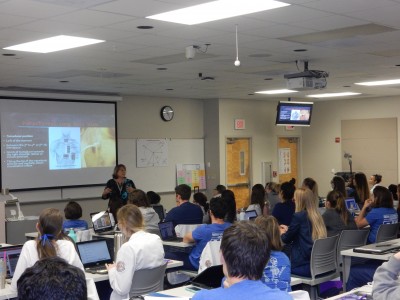NSU Newsroom
SharkBytes
Horizons
This version of NSU News has been archived as of February 28, 2019. To search through archived articles, visit nova.edu/search. To access the new version of NSU News, visit news.nova.edu.
This version of SharkBytes has been archived as of February 28, 2019. To search through archived articles, visit nova.edu/search. To access the new version of SharkBytes, visit sharkbytes.nova.edu.
The Role of Ultrasound Expands in Interprofessional Education
Dr. Pallavi Patel College of Health Care Sciences

Deborah Mendelsohn, D.H.Sc., RDMS, RDCS, RVT, assistant professor and clinical coordinator, presents to the physician assistant students at the Fort Lauderdale/Davie Campus
Interprofessional Education intended for the health care profession is focused on engaging students in interactive learning. The goal is to integrate knowledge and skills from professions outside of their specialty.
This integration will require interprofessional education to become part of the curriculum rather than just an additional lecture to be added on to an already existing course. This trend has been extremely evident for the medical sonography field, which is now being taught to other health professions, specifically medical and physician assistant students.
During the past four years, Medical Sonography (MS) faculty members at the Fort Lauderdale/Davie Campus were invited to provide an annual lecture with a correlating lab
session to the NSU Physician Assistant (PA) Program at the Fort Lauderdale/Davie and Jacksonville campuses. The lecture content is aimed at point-of-care ultrasonography, which is intended to help students understand and learn how to obtain sonographic images.
Point-of-care-ultrasonography is intended for the practitioner, because it helps in providing the answers to a working hypothesis during a physical examination. An immediate diagnosis will result in a speedy treatment plan of action for life-threatening cases, such as deep-vein thrombosis, ectopic pregnancies, obstructive nephrolithiasis, and emergent traumatic occurrences.
A full-day training session was given to the Fort Lauderdale/Davie physician assistant students, which included a lecture-and- lab session that was overseen by a medical sonography student and supervised by the MS faculty. The lecture content included principles of physics on how sound travels through a medium, as well as the ability to differentiate the anatomy as seen on a sonographic image.
The lab sessions offered the students an opportunity to apply their knowledge and practice their scanning skills during the hands-on session. With these trainings, the college is not only increasing the knowledge of students from both professions, but also improving the future levels of cooperation, coordination, and collaboration between these professionals while delivering patient-centered care.
The location of both MS and PA programs is beneficial for faculty members and students to interact and have access to the ultrasound equipment beyond the needs of the point-of-care lectures. It provided an opportunity to enhance the Electrocardiography (ECG) course taught to the PA students at the Fort Lauderdale/Davie Campus by using ultrasound to visualize the correlation between the electrical activity and the heart in motion.
The initial lecture provided a live demonstration of the heart contracting and relaxing throughout cardiac cycle. The demonstration provided a frame-by-frame perspective of the heart during systole and diastole. The success of these ultrasound trainings led to an improved, expanded lecture the following year, which taught the PA students about the windows used to obtain and recognize the different views evaluated during an echocardiogram exam, as well as the correlation between the ECG and heart movement.
The prospects for further collaboration and course enhancement with ultrasound have the potential to grow exponentially. The goal of the MS Program is to continue working with the PA, physical therapy, and osteopathic medicine programs, and to expand to other health professions to help make ultrasound an integral part of their education.
Finally, the ultrasound trainings offered to the PA students in the Fort Lauderdale/Davie and Jacksonville campuses have allowed faculty members to develop new instructional skills that could be used as a model of cooperation across the health professions. More importantly, they have allowed MS and PA students to learn about each other’s professions and cooperate with each other to obtain better results, with the potential to improve the quality of care.